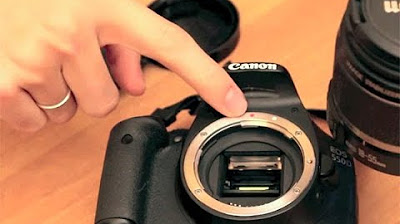Belajar DASAR KAMERA Untuk Pemula.. !!
Summary
TLDRThe video discusses the basics of cameras, focusing on the differences between DSLR and mirrorless cameras, and the key features that make each type unique. The speaker explains technical terms such as aperture, ISO, and shutter speed, and how they influence photo quality. It offers practical advice on setting up a camera, understanding exposure, and capturing high-quality images. The speaker uses simple analogies and step-by-step guidance, making it accessible for beginners looking to enhance their photography skills. Future episodes may delve deeper into camera settings and techniques.
Takeaways
- 📸 Basic camera series introduction, covering essential concepts for beginners.
- 🎥 The video uses a Canon EOS with a slider for smooth shots.
- 🔍 Explanation of DSLR cameras, using a mirror system to direct light to the sensor.
- 🔄 Mirrorless cameras, like the one being used, are a modern upgrade without mirrors, allowing light directly into the sensor.
- 📷 Differences between DSLR and mirrorless cameras, similar to comparing manual and automatic cars.
- 💡 Discussion on the exposure triangle: ISO, aperture, and shutter speed, and how to balance them for optimal results.
- 🌐 ISO increases brightness artificially but can cause noise in dark areas or cheaper cameras.
- 🔦 Aperture controls the lens opening, affecting depth of field and natural light entry.
- ⏱ Shutter speed determines how long the sensor is exposed to light, crucial for capturing motion.
- 📽 For video recording, frame rate and shutter speed should be balanced (e.g., 24 fps with 1/48 shutter speed).
Q & A
What is a DSLR, and how does it work?
-A DSLR, or Digital Single-Lens Reflex camera, uses a mirror system that reflects light from the lens to an optical viewfinder. This allows the user to see exactly what the camera sensor will capture. The mirror flips up when the shutter is released, allowing light to hit the sensor and capture the image.
What is the difference between a DSLR and a mirrorless camera?
-The main difference is that DSLRs use a mirror mechanism to reflect light to the viewfinder, whereas mirrorless cameras do not have a mirror. In a mirrorless camera, light passes directly to the sensor, and the user relies on an electronic viewfinder or the display to see the image.
How does the ISO setting affect image quality?
-ISO controls the camera's sensitivity to light. A higher ISO allows more light to be captured, which is useful in low-light conditions, but it can introduce noise, making the image grainy. A lower ISO provides a cleaner image but requires more light.
What is aperture, and how does it impact photography?
-Aperture refers to the size of the lens opening, which controls how much light enters the camera. A lower f-stop (e.g., f/2) means a larger aperture and allows more light in, creating a shallow depth of field (blurry background). A higher f-stop (e.g., f/22) results in a smaller aperture, allowing less light and increasing depth of field (sharper background).
What is the 'exposure triangle' in photography?
-The exposure triangle is the relationship between three key settings: ISO, aperture, and shutter speed. These three elements work together to control the amount of light entering the camera, helping achieve a well-exposed image.
What is shutter speed, and why is it important?
-Shutter speed refers to how long the camera's sensor is exposed to light. A fast shutter speed (e.g., 1/1000 sec) can freeze motion, while a slow shutter speed (e.g., 1 second) allows for more light but can cause motion blur. It's crucial for capturing action or long-exposure shots.
What are the advantages of using a mirrorless camera over a DSLR?
-Mirrorless cameras are typically lighter, more compact, and quieter than DSLRs. They offer faster autofocus in many cases, and because they don’t have a mirror mechanism, they allow for quicker shooting. However, battery life may be shorter compared to DSLRs.
Why does a lower aperture value (e.g., f/2) create more background blur (bokeh)?
-A lower aperture value, or wider aperture, allows more light to hit the sensor and reduces the depth of field. This means the subject is in sharp focus while the background appears blurred, creating a bokeh effect.
What is the relationship between shutter speed and motion blur?
-A slower shutter speed increases the likelihood of motion blur because the sensor is exposed to light for a longer time, capturing any movement. A faster shutter speed reduces motion blur, making it ideal for capturing fast-moving subjects clearly.
What settings are important for shooting in low light conditions?
-In low light conditions, it's important to use a larger aperture (lower f-stop) to allow more light in, increase the ISO to boost light sensitivity (while being mindful of noise), and use a slower shutter speed to capture more light without compromising image sharpness.
Outlines

Этот раздел доступен только подписчикам платных тарифов. Пожалуйста, перейдите на платный тариф для доступа.
Перейти на платный тарифMindmap

Этот раздел доступен только подписчикам платных тарифов. Пожалуйста, перейдите на платный тариф для доступа.
Перейти на платный тарифKeywords

Этот раздел доступен только подписчикам платных тарифов. Пожалуйста, перейдите на платный тариф для доступа.
Перейти на платный тарифHighlights

Этот раздел доступен только подписчикам платных тарифов. Пожалуйста, перейдите на платный тариф для доступа.
Перейти на платный тарифTranscripts

Этот раздел доступен только подписчикам платных тарифов. Пожалуйста, перейдите на платный тариф для доступа.
Перейти на платный тарифПосмотреть больше похожих видео
5.0 / 5 (0 votes)






